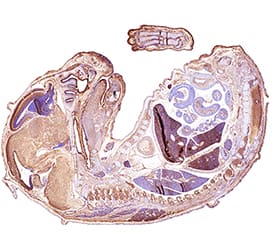Human/Mouse/Rat Slit3 Antibody
R&D Systems, part of Bio-Techne | Catalog # AF3629

Key Product Details
Species Reactivity
Validated:
Human, Mouse, Rat
Cited:
Mouse, Transgenic Mouse
Applications
Validated:
Immunohistochemistry, Neutralization
Cited:
Immunohistochemistry, Neutralization, Western Blot
Label
Unconjugated
Antibody Source
Polyclonal Goat IgG
Product Specifications
Immunogen
Mouse myeloma cell line NS0-derived recombinant mouse Slit3
Ser27-His901
Accession # Q9WVB4
Ser27-His901
Accession # Q9WVB4
Specificity
Detects human, mouse and rat Slit3 in Western blots.
Clonality
Polyclonal
Host
Goat
Isotype
IgG
Endotoxin Level
<0.20 EU per 1 μg of the antibody by the LAL method.
Scientific Data Images for Human/Mouse/Rat Slit3 Antibody
Slit3 in 13 D.P.C. Mouse Embryo.
Slit3 was detected in immersion fixed paraffin-embedded sections of 13 d.p.c. mouse embryo using Goat Anti-Human/Mouse/Rat Slit3 Antigen Affinity-purified Polyclonal Antibody (Catalog # AF3629) at 5 µg/mL for 1 hour at room temperature followed by incubation with the Anti-Goat IgG VisUCyte™ HRP Polymer Antibody (VC004). Before incubation with the primary antibody, tissue was subjected to heat-induced epitope retrieval using Antigen Retrieval Reagent-Basic (CTS013). Tissue was stained using DAB (brown) and counterstained with hematoxylin (blue). Specific staining was localized to developing braiin and cartillage.Applications for Human/Mouse/Rat Slit3 Antibody
Application
Recommended Usage
Immunohistochemistry
5 µg/mL
Sample: Immersion-fixed paraffin-embedded 13 d.p.c. mouse embryo
Sample: Immersion-fixed paraffin-embedded 13 d.p.c. mouse embryo
Neutralization
In a functional ELISA, 3-18 µg/mL of this antibody will block 50% of the binding of 500 ng/mL of Recombinant Human ROBO2 Fc Chimera (Catalog # 3147-RB) to immobilized Recombinant Mouse Slit3 (Catalog # 9296-SL) coated at 500 ng/mL (100 µL/well). At 25 µg/mL, this antibody will block >80% of the binding.
Formulation, Preparation, and Storage
Purification
Antigen Affinity-purified
Reconstitution
Reconstitute at 0.2 mg/mL in sterile PBS. For liquid material, refer to CoA for concentration.
Formulation
Lyophilized from a 0.2 μm filtered solution in PBS with Trehalose. *Small pack size (SP) is supplied either lyophilized or as a 0.2 µm filtered solution in PBS.
Shipping
Lyophilized product is shipped at ambient temperature. Liquid small pack size (-SP) is shipped with polar packs. Upon receipt, store immediately at the temperature recommended below.
Stability & Storage
Use a manual defrost freezer and avoid repeated freeze-thaw cycles.
- 12 months from date of receipt, -20 to -70 °C as supplied.
- 1 month, 2 to 8 °C under sterile conditions after reconstitution.
- 6 months, -20 to -70 °C under sterile conditions after reconstitution.
Background: Slit3
References
- Yuan, W. et al. (1999) Dev. Biol. 212:290.
- Howitt, J. A. et al. (2004) EMBO J. 23:4406.
- Long, H. et al. (2004) Neuron 42:213.
- Greenberg, J. M. et al. (2004) Dev. Dyn. 230:350.
- Liu, J. et al. (2003) Mech. Dev. 120:1059.
- Yuan, W. et al. (2003) Proc. Natl. Acad. Sci. USA 100:5217.
- Little, M. H. et al. (2001) Am. J. Physiol. Cell Physiol. 281:C486.
Long Name
SLIT Homolog 3
Alternate Names
MEGF5, SLIL2
Gene Symbol
SLIT3
UniProt
Additional Slit3 Products
Product Documents for Human/Mouse/Rat Slit3 Antibody
Product Specific Notices for Human/Mouse/Rat Slit3 Antibody
For research use only
